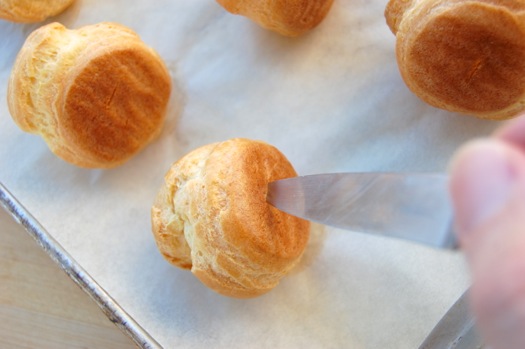The Science of Pâte à Choux

Choux is a truly ingenious invention, though it almost certainly wasn’t “invented” in the classic sense of the word. It evolved, probably through decades, maybe even centuries, of trial and error. The secret of choux is that it’s “double cooked”, a process that imbues it with some very special properties.
If you’ve made éclair or cream puff shells before, you probably recall the process. Water and butter are combined in a sauce pan and heated to the boil, at which point enough flour is added to turn the mixture into a fairly stiff paste. That paste is then cooked over low heat until it forms a ball, which is then finished by beating in several eggs, one after the other. It’s then piped and baked (the second “cooking”). Interesting. Curious. But what does it all mean?
Choux is a batter which by design contains a lot of activated gluten, and that’s unusual. Normally batters, regardless of how thick they are, are low-gluten affairs. Recall how one is time and again admonished not to stir a pancake batter for fear of toughening the cakes. The same goes for muffin batters, where agitation leads to big bubbles or “tunnels”, crowning and a gummy texture. That logic is reversed with choux, which is beaten vigorously in an attempt to activated the gluten and turn the entire thing into one giant bubble.
But then what does the double cooking accomplish? For one it causes the flour to gelatinize, which creates a starch mesh that helps reinforce the gluten. When baked, these dual networks help the bubble of expanding batter to stretch (they also help prevent steam from escaping). But the cooking also does something else. It partially denatures (science-speak for “messes up”) the gluten molecules so that they lose some of their elasticity, helping to ensure that when the single bubble is fully expanded it doesn’t snap back before the pastry hardens.
Amazing, n’est pas?
Happy Lunar New Years Joe! May your site be prosperous as always.
I’m going to be making crispy topped choux with filled with red bean diplomat cream for Chinese New Years! And some filled with vanilla, but with a red crispy top.
Let me know when they’re up on your blog! I want to see them!
– Joe
The crispy tops I colored with red coloring paste turned out more deep pink than red (perhaps I didn’t add enough coloring). I will most definitely inform you when they’re posted!
Keep trying, Vicki! And thanks!
– Joe
Amazing indeed. Betting on someone to invent this concept serendipitously, let alone intentionally, is going against the odds.
I would think so too, Uptight. You’d have had to be quite the pre-industrial R&D genius to figure it out. I’m betting it was lots of small, incremental steps.
Cheers,
– Joe
Indeed it is interesting – thank you. 🙂
My pleasure as always, Heather!
– Joe
Bless you! Gesundheit! (Sorry, I just couldn’t resist!)
I just stumbled across your site for something completely unrelated to this post, high-ratio cakes, and ended up bookmarking it for future reference. Understanding the science is a big issue for me as I grew up at sea level and have lived the better part of the past ten years at 7,000 feet in elevation where your basic chocolate chip cookies are weapons instead of tasty treats and cakes are a complete disaster. Combine that with my nerdy charm, and I decided I’d better figure out what makes pastries and breads do what they do so they would work up in the stratosphere.
Ha! Hey Beth!
And welcome! The key thing to remember up there is that the lower pressure will make bubbles bigger. And if they get too big they pop, collapsing everything. So you want to cut back on your leaveners and rising times to compensate. Get in touch if I can be of help with anything!
Cheers,
– Joe
I have used this technique for years to make Jewish Passover “rolls” with matzah meal (instead of flour.) After making numerous batches during the week-long holiday, it’s no wonder the idea of a cream puff or popover never excites me.
No kidding! Fascinating, Laurie. It makes perfect sense. Let me know how the cream puffs turn out!
Cheers,
– Joe
What do you think fo Shirley Corriher’s method of using more egg whites than yolks to help dry out the batter for a crispier result?
Hey Henry!
I love Shirley Corriher! That’s a good method for crispy choux, though I’ll say that an even better method is to make them with craquelin on top.
http://joepastry.com/category/pastry-components/choux-craquelin-beard-papa/
That gives you the crispiness but you also get to keep some of the moisture too! Cheers,
– Joe